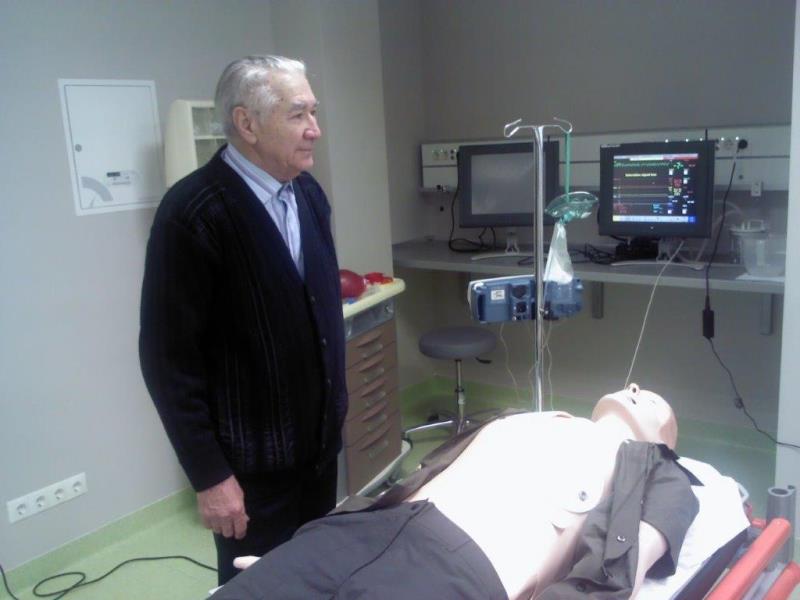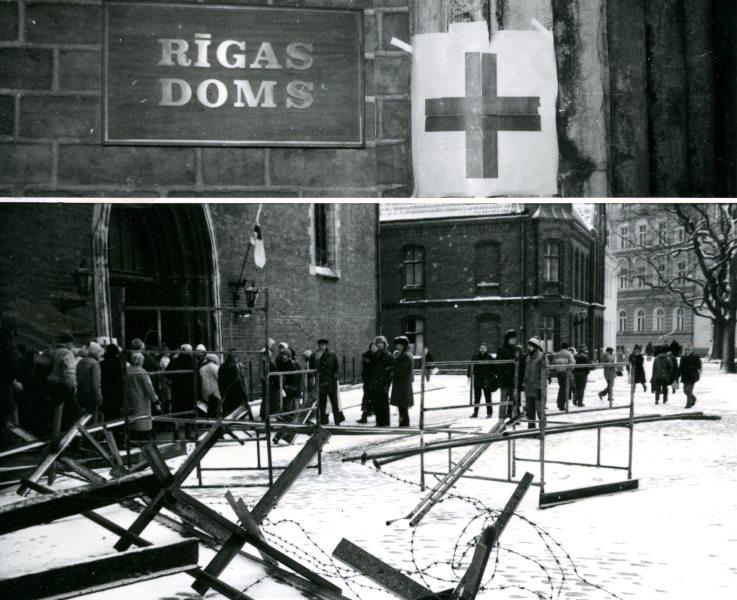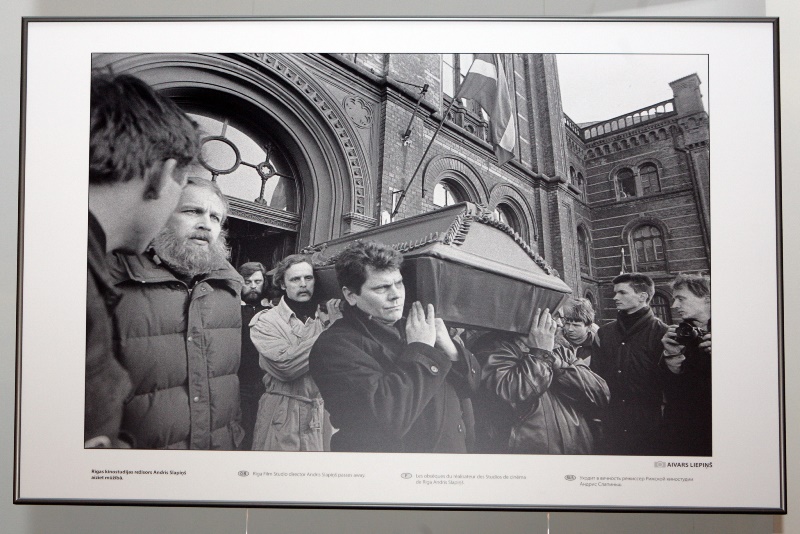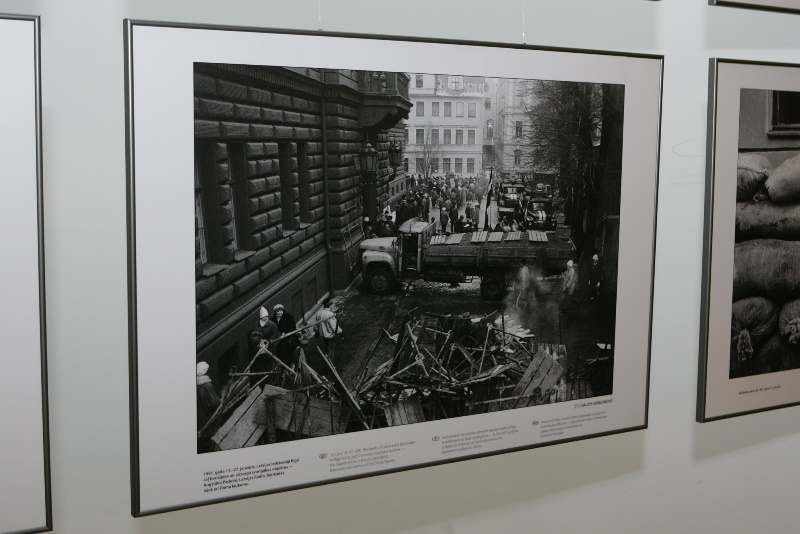Former RSU Asst. Prof. Anatolijs Ņikitins: My Memories of the 1991 Barricades
Anatolijs Ņikitins is a former Assistant Professor at Rīga Stradiņš University (RSU). He was born in 1928 and participated in the Barricades in Riga in January of 1991.
These memories were recorded on 7 January 2016 and are kept by the RSU Museum.
 In 2013 Anatolijs Ņikitins visited the RSU Medical Education Technology Centre (METC), curious to see how prospective doctors were being taught. Photo from the RSU Museum collection.
In 2013 Anatolijs Ņikitins visited the RSU Medical Education Technology Centre (METC), curious to see how prospective doctors were being taught. Photo from the RSU Museum collection.
I was the Head of the Department of Hospital Surgery in the Medical Academy of Latvia (now RSU) and the head of the Clinic of Surgery at Riga 1st Hospital at the time. When the Barricades began, we started to prepare. First, we discharged all the patients from the hospital who were able to go home in order to free up beds. We anticipated that anything could happen. We had seen what was happening in Lithuania on TV. We also ordered emergency supplies of medicine and blood substitutes. In addition, my colleagues, all the doctors and nurses, were on guard at the Riga Cathedral where a medical station had been set up. I was not there myself, because I was managing the clinic. There were still patients who were seriously ill who needed my care.
Senior students from the Medical Academy were also involved. It was a heroic job – at night, they were on duty at the Riga Cathedral, but in the morning, they came back to the clinic and continued their work there.
Our hospital's Head Physician Zoja Orlova was very helpful to procuring and preparing medicines and tools. By the way, she sent warm lunches to our colleagues on duty at the Riga Cathedral every day.
 The Barricades by the Riga Cathedral, January 1991. Pulss newspaper. Photo from the RSU Museum collection.
The Barricades by the Riga Cathedral, January 1991. Pulss newspaper. Photo from the RSU Museum collection.
Many people came to the hospital during The Barricades to give blood as a donation centre had been set up there.
On the evening of 20 January, I was at home watching television, when I heard about the shootings that were reportedly taking place at the Ministry of the Interior. We at the Riga 1st Hospital were an ambulance clinic, and I lived quite close to the hospital.
I rushed to the hospital immediately as I guessed that people would get injured. As I was running along Skolas iela, bullets flew high above my head and I could hear the shots. When I arrived, I found out that camera operator Andris Slapiņš had already died on his way to the hospital.
 Andris Slapiņš’ coffin being brought out of the Riga Cathedral on 25 January 1991. Thousands of people gathered at the funerals of the victims of the shootings. Photo from the 2011 exhibition Latvian Medics on the 1991 Barricades from Pauls Stradiņš Museum of the History of Medicine. Photo credit: F64
Andris Slapiņš’ coffin being brought out of the Riga Cathedral on 25 January 1991. Thousands of people gathered at the funerals of the victims of the shootings. Photo from the 2011 exhibition Latvian Medics on the 1991 Barricades from Pauls Stradiņš Museum of the History of Medicine. Photo credit: F64
When I entered the operating room, a victim had just been brought in - it was cameraman Gvido Zvaigzne. Asst. Prof. Ojārs Aleksis and I examined the victim and discovered that he was seriously injured - the bullet had hit him from behind, passed through the lungs, the diaphragm, the liver, grazed the right kidney and the large intestine, and got stuck under the skin in the back. He was unconscious. Fortunately, we were able to operate on him immediately as everything had been prepared beforehand and the entire operation team was on standby.
Asst. Prof. Aleksis and I both operated on Zvaigzne. We did everything we could to save the man, but his injuries were serious, and the prognosis wasn’t good.
The patient needed an urgent blood transfusion during the operation. If I remember correctly, his blood type was rhesus negative and we were in short supply of this blood type. The anaesthesiologist for this operation, Dace Nagobade, donated her blood then and there as her blood type matched Zvaigzne's. After the operation, Zvaigzne remained in the intensive care unit. His condition was very serious. We called a consultant from Estonia, a surgeon with a lot of experience from Afghanistan in treating similar injuries. Chief surgeons from the Riga Military Hospital also took part in the consultations. We fought for Zvaigzne’s life for more than two weeks. We also received very good respiratory equipment from Sweden, but ultimately, we were unfortunately not able save his life.
We had just finished operating on Zvaigzne when two more victims were brought in. One of them was a police officer from the Ministry of the Interior. I don't remember his last name, but he was Lithuanian by nationality. He later told me how he had been injured: the OMON had started knocking on the doors aggressively, then the shooting had commenced and he had been injured. The bullet had hit his leg at the pelvic joint and injured the artery. He was operated on by another team, but I was asked to join this operation after I had finished operating on Zvaigzne because I had a lot of experience in vascular surgery.
We were thankfully able to sew and repair the blood vessel. The victim survived and later often sent us holiday greetings from Lithuania, where he had returned for his recovery.
The third victim was also a police officer. He had sustained an injury to his abdomen, pancreas, and intestines. We operated on him successfully, but then he was transferred to the Military Hospital. I don't remember the reason why he had to be transferred. But he survived as well, thank God.
I remember that we worked throughout the night. Journalists, also from abroad, came the next day, and we had to give interviews.
And so, we stayed at the hospital day and night while the Barricades lasted. Students worked as volunteers. Some of them had already been working with us as assistant doctors in the operating room, for example. 6th-year students volunteered in the clinic. Everyone was very enthusiastic at the time.
 Barricades in the narrow streets of the Old Town of Riga, January 1991. Photo from the 2011 exhibition Latvian Medics on the 1991 Barricades in Pauls Stradiņš Museum of the History of Medicine. Photo credit: F64
Barricades in the narrow streets of the Old Town of Riga, January 1991. Photo from the 2011 exhibition Latvian Medics on the 1991 Barricades in Pauls Stradiņš Museum of the History of Medicine. Photo credit: F64
Later, all hospital staff, both doctors and nurses, were awarded by the Lāčplēsis Foundation, and then received the Commemorative Medal for Participants of the Barricades of 1991. In addition to that, I was awarded the Order of the Three Stars in 1998. I was also awarded the medal for being one of the first doctors to begin heart surgery in Latvia.
Related news
 Sustainable ideas and an innovation bootcamp in Vienna – RSU students invited to apply for the Green Hexagon programmeFor RSU Employees, For Students, Innovation
Sustainable ideas and an innovation bootcamp in Vienna – RSU students invited to apply for the Green Hexagon programmeFor RSU Employees, For Students, Innovation


